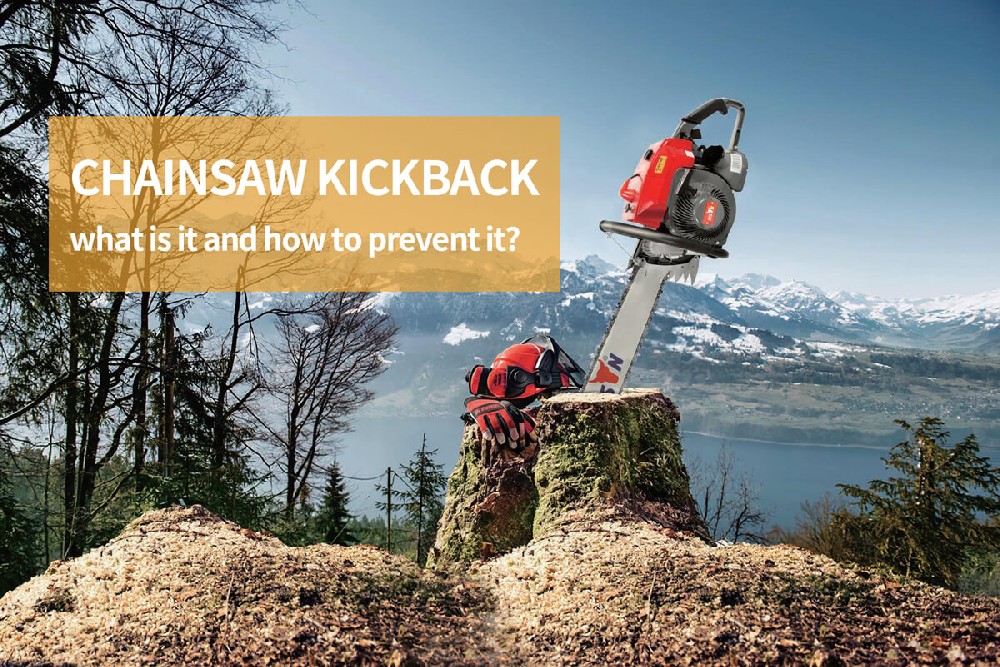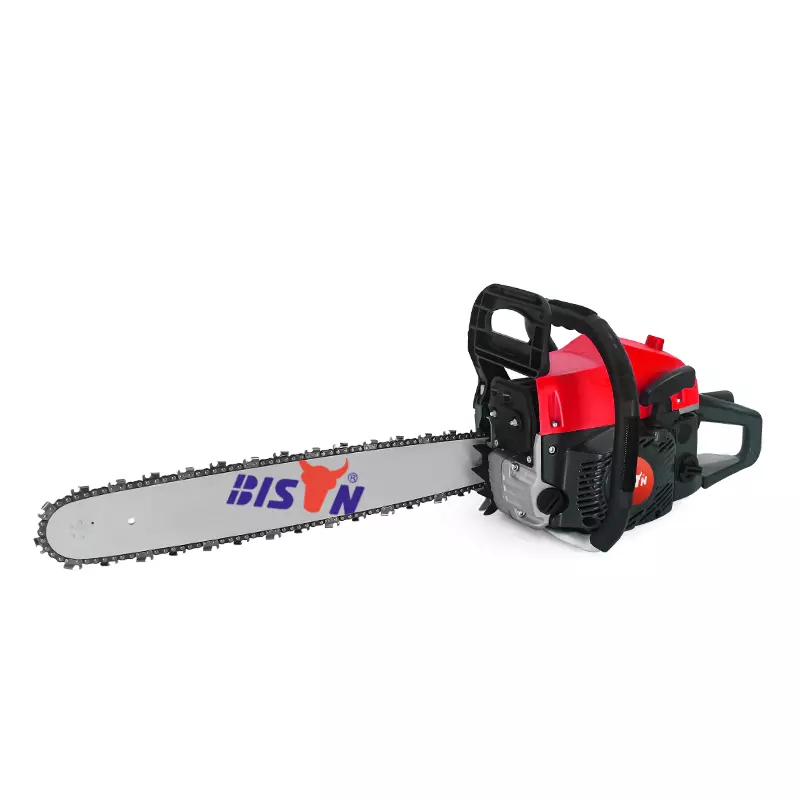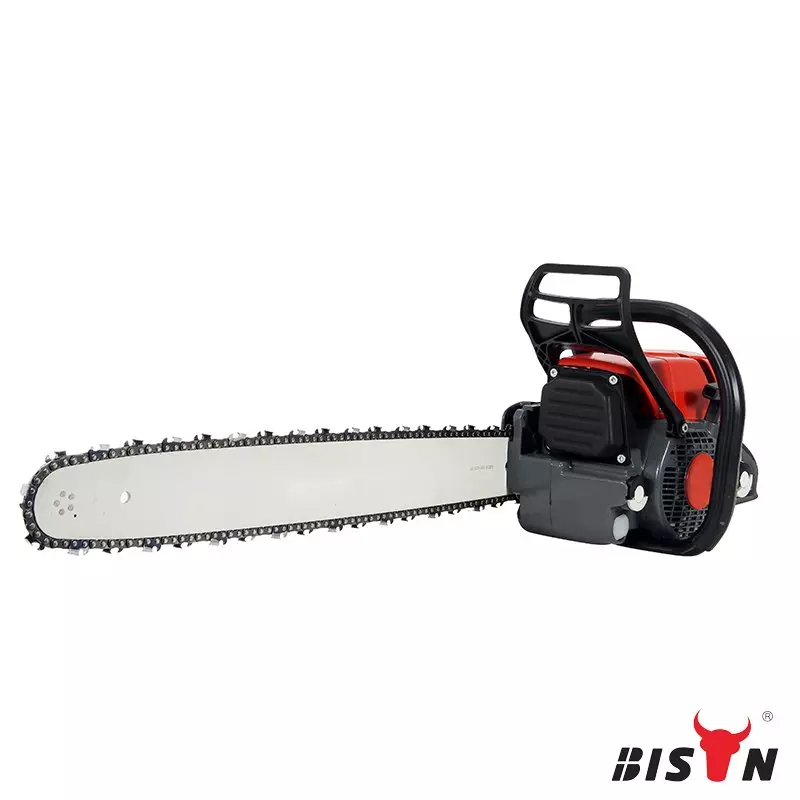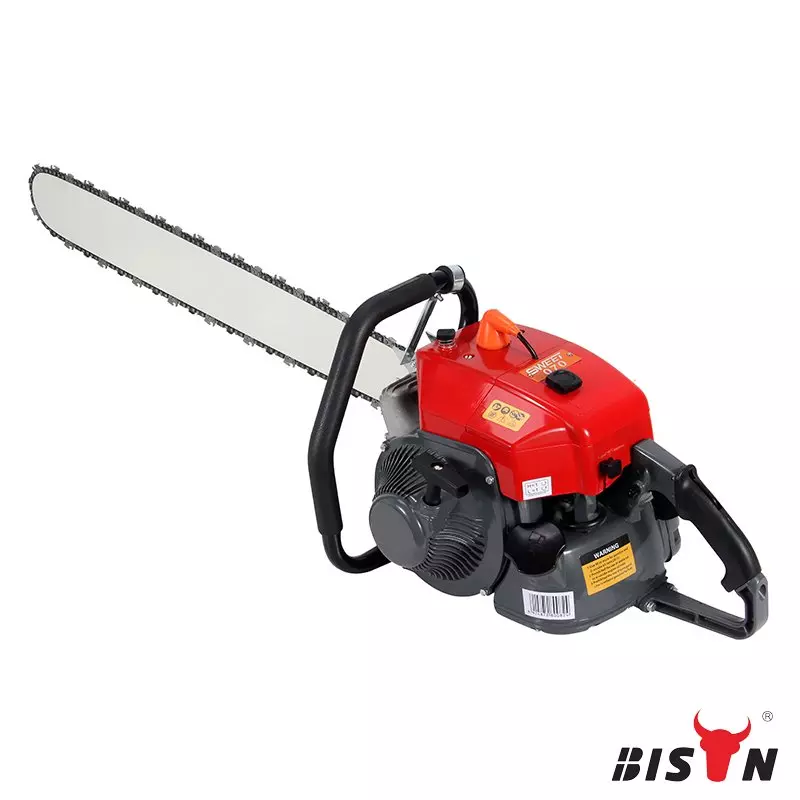chainsaw kickback: what is it and how to prevent it
2023-12-26
Table of content
In a world, chainsaws have emerged as powerful assets, staples in the arsenal of both professionals and DIY enthusiasts alike. Its primary use ranges from tree felling, limbing, and bucking, to pruning shrubs and trees and cutting firebreaks in wildland fires.
However, chainsaws are not bereft of hazards. One of the most dangerous occurrences, is the phenomenon known as 'chainsaw kickback', an unexpected reactionary force that can cause severe injuries.
Maybe, you've probably already experienced the unpleasant sensation of the chain catching and creating backward momentum. It's a feeling that will take your breath away.
So, what exactly is chainsaw kickback, and how can you prevent it from happening? Our article provides clear information on chainsaw kickback.
Let's turn these risks into merely talking points and enrich our understanding, ensuring that every cut we make is as safe as possible.

What is chainsaw kickback?
Chainsaw kickback is a sudden and violent jerk of the chainsaw, typically either in an upward and backward direction. This can happen with gasoline and electric chainsaws, creating a hazardous situation, catching off guard even those most familiar with this potent tool. Kickback occurs in just a tenth of a second when the chain suddenly stops as a link comes into contact with the wood.
Types of Kickback
The nuances of chainsaw kickback can be further divided into specific types, each with its particular triggers and movement patterns. We'll look at the different types of kickbacks that can happen and what you need to watch out for.
Rotary kickback: This is the most typical and also the most dangerous. It occurs when the upper quadrant of the chainsaw tip - an area often referred to as the "kickback zone" - contacts an object. When the cutting angles of the teeth are backward, they run over the wood instead of cutting through it. Putting the teeth into the wood rather than grinding it forces the bar's tip upwards towards you. It will catch you by surprise, and you'll lose control and get a kickback, all in a split second.
Pinch or clamp kickback: This situation arises when the wood closes in and pinches the chainsaw's chain within the cut. Therefore, if at any point the chain is pinched or locked on either side of the object, the chain will be pushed back at full throttle due to more force. Don't pinch the chain, and be extremely careful and alert.
Pull-in kickback: If you hit a piece of wood or a nail on the other end while using the saw, the saw will move forward and away from your grip.
Not all kickbacks have much of a driving force behind them. They may not be overly violent and contain only a slight retardation. However, extreme conditions will cause your saw to kick back at you, causing a severe cut or worse. But the toll of chainsaw kickbacks extends far beyond physical harm. The emotional impact following such an event can be profound. Simultaneously, the financial implications can be significant.
What causes kickbacks on chainsaws?
To successfully forestall chainsaw kickbacks, it's necessary to discern the key contributors to these potentially devastating occurrences. There are a few different conditions that can cause chainsaw kickback.
Improper cutting techniques
One of the chief instigators of chainsaw kickbacks involves employing incorrect or unsafe cutting methods. If you touch the cutting surface of the rotating chain in this area, you can cause kickback. A pinched chain can also cause kickback. This often happens when working on an uneven surface with your saw, but it can also occur when assembling the wood into individual logs.
Equipment problems
Issues with the chainsaw itself can dramatically heighten the kickback risk. A dull or blunt chain that struggles to cut smoothly through material can lead to uncontrolled jerks and forceful movements of the chainsaw. Loosely fitted chain tension can trigger erratic chainsaw motions and can easily provoke kickbacks. Moreover, a damaged chainsaw bar or a faulty chain brake incapable of arresting the chain's motion during a kickback situation can result in hazardous consequences.
Work environment
The physical work environment and conditions also play a critical role in chainsaw kickbacks. Actions such as cutting at or above shoulder height can lead to the chainsaw being less controllable and more prone to kickback. Additionally, if the cutting path isn't clear, the chainsaw could easily make contact with unexpected obstacles, triggering a kickback. Furthermore, unpredicted elements in working, like knots or embedded branches, can abruptly halt the chainsaw's smooth movement, leading to a violent reactionary force.
How do you prevent chainsaw kickbacks?
Kickback prevention requires a culmination of safety knowledge, apt operational techniques, and routine equipment maintenance, supported by a keen awareness of your work environment. Here's a practical, integrated approach to significantly reduce the risk of chainsaw kickbacks:
Safety measures and equipment
Acquainting oneself with the safety features of the chainsaw is the initial step to preventing kickbacks. Understanding functions like chain brakes (which can stop the chain if sudden motion is detected) and low-kickback chains can greatly enhance your safety.
The chain brake is usually in front of your grip and can be activated by pushing against it with your wrist. When your chainsaw kicks in, it should automatically press on your wrist to engage. When activated, the chain brakes disconnect the chain.
There are chains you can purchase and install on your saw that reduce the chance of kickback. These function by limiting the amount of fibers that can catch and retract; frequently, this is accomplished by increasing the amount of metal in between each cutter.
Additionally, one should always wear appropriate safety gear - even if it's just for a moment. Wear a helmet, goggles, long sleeves, steel-toed boots, and chaps with ear protection. You may still get hurt, but the injuries won't be as extensive.
Environmental safety
Maintaining a clear cutting path is essential. Eliminate any potential obstructions that may deflect the saw or pinch the chain, leading to kickback. Cultivate a keen sense of your surroundings and always be ready for kickback.
Chainsaw handling techniques
Proper handling techniques can dramatically decrease the occurrence of kickbacks.
Using the chainsaw with both hands: With one hand, chainsaw control is significantly reduced. It can slip or slide, potentially causing accidents. To hold the chainsaw correctly, the right hand is placed on the back handle and the left on the front handle. A firm grip avoids kickbacks and thus handles the device better. Also, it should not be placed at arm's length or above the chest.
Maintain correct posture: Use the right body alignment and keep the chainsaw level. Stand to the side of your cutting path, not directly behind it.
Avoid the tip: The top of the chainsaw bar end is called the "kickback danger zone." Kickback risk is high in this area. You should never see this part of the chainsaw bar being used, as doing so will significantly increase your chances of experiencing a kickback. The larger the size of the bar nose, the greater the chance of chainsaw kickback.
choose low or medium revs: Even if a higher cut helps reduce the risk of kickback, choose low or medium revs if you are using a chainsaw. Control will only improve, especially in critical situations.
Chainsaw maintenance
Proper maintenance is first on the list. Maintain your chainsaw by performing all safety checks and preventive maintenance promptly to ensure a safe working environment.
Sharp and lubricated chains: Blunt links have to work harder to cut, increasing the risk of kickbacks. Regular sharpening and chain lubrication ensure a smoother, safer cutting process.
Chain tension: A loose chain runs the risk of binding or coming off the bar, both scenarios leading to potential kickbacks. Ensure your chain has the right tension and is properly fitted around the bar.
Safety checks: Regularly inspect your chainsaw's various parts for damage. Verify that the chain brake functions properly and stops the chain. Wear, or the presence of oil, dirt, or dust on the brake parts can significantly reduce a chain brake stopping power.
Additional tips:
Take breaks to avoid fatigue, which can decrease focus and awareness.
Never cut two logs at the same time.
Match the chain and bar for the exact pitch and gauge.
Set the depth gauges to the manufacturer's settings.
Concluding thoughts: promoting chainsaw safety
Chainsaws are helpful equipment. But if you use them carelessly, they can also prove to be extremely dangerous.
The essence of avoiding chainsaw kickback lies in the triad of knowledge, safe practices, and proper equipment maintenance. Knowing what kickback is and the common scenarios that cause it, adhering to proper cutting techniques, maintaining a safe working environment, and ensuring your chainsaw is always in good repair creates a robust safety net.
Our comprehensive guide will be handy if you're a beginner to sawing or struggling with chainsaw kickbacks. It cannot be stressed enough that safety should always be at the forefront of every operation.
Let our discussion on chainsaw kickback not breed fear but foster vigilance. Handling your chainsaw with confidence.

Call to action: Stay safe with a BISON chainsaw
As we highlight the various ways to prevent chainsaw kickback, it is appropriate to acknowledge the critical role that the chainsaw design itself plays in mitigating such incidents. Manufacturers play a key role in improving safety features and designing better, safer chainsaws.
This, dear reader, is where BISON steps in, marking the evolution of chainsaw safety. BISON, a well-known Chinese chain saw manufacturing company, has set new safety standards, incorporating numerous features designed to reduce the risk of kickback and ensure optimal user protection.
Our chainsaws are designed with anti-kickback mechanisms and chain brakes that automatically stop the chain in case of kickback. Additionally, the chain saw is designed to operate only when the button is pressed and the throttle lock is engaged, reducing the risk of accidental starting.
With state-of-the-art chain sensor technology (a first in chain saw design), any chain break or derailment event will cause the chain to stop immediately, preventing potential hazards. Additionally, the right side guard provides added safety in the event of chain derailment or breakage.
In addition to these safety features, BISON offers a range of chainsaw models suitable for a variety of cutting tasks. We offer chains in different profiles, each designed to meet your specific needs while minimizing the risk of kickbacks. So, whatever the nature of your job, you can be assured of a model that combines your requirements with the highest safety standards.
We invite chain saw dealers around the world to demonstrate your commitment to safety by choosing BISON. Import our range of high quality, safety enhanced chainsaws. Choose BISON, choose security.



